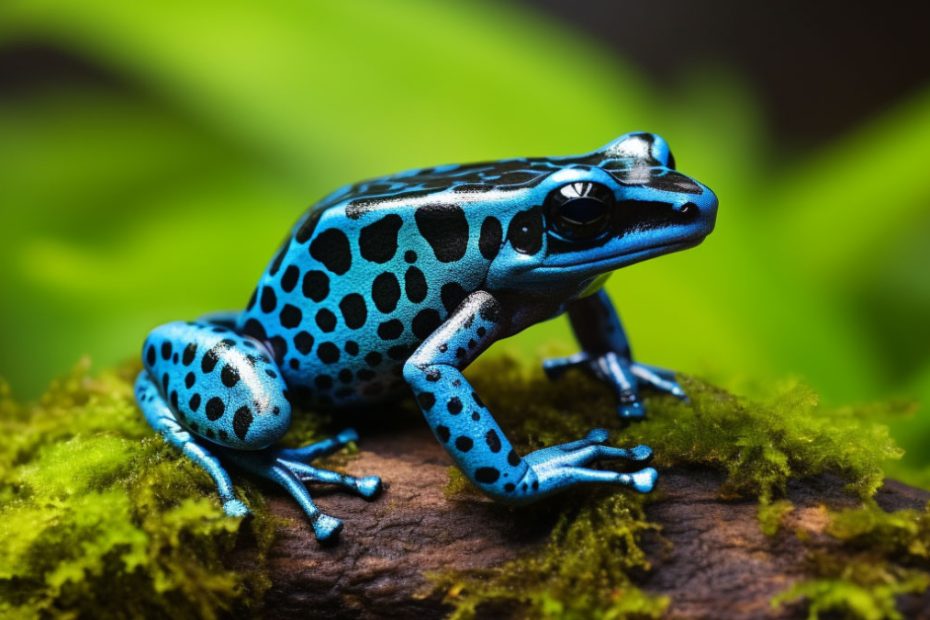Though poison dart frogs are colorful and beautiful creatures, they are one of the most poisonous creatures. In the wild, their toxins can even cause the death of humans.
But are poison dart frogs poisonous in captivity also? Generally, no, but they can be toxic. When they are in captivity, they won’t consume the toxic insects that they do in the wild. That’s why their skin glands will also eventually stop secreting toxins. Yet, they will retain a negligible level of toxicity in captivity.
Throughout this article, we will enlighten you about how safe these frogs are in captivity. You will also learn the reasons for their loss of toxicity. Hence, read until the end.
Are Poison Dart Frogs Poisonous In Captivity?
No. Though poison dart frogs are deadly in the wild, they lose their toxicity in captivity. But your wild-caught poison frog will retain toxicity for some time. Over time, they will become non-poisonous.
Generally, in the wild, a poison dart frog will secrete toxins like batrachotoxins, pumiliotoxins, histrionicotoxins, and nephrotoxins. Among these, batrachotoxins and pumiliotoxins are more deadly for animals than the other two. Granular glands of these types of frogs can synthesize, produce, and store these toxins.
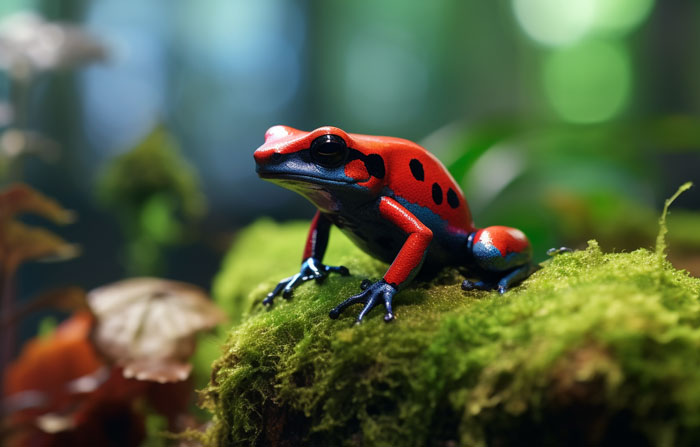
Upon feeling any potential threat, they will release these toxins through their glands. Thus, when their predators touch or try to eat them, these toxins may cause:
- Paralysis
- Nausea
- Swelling
- Depolymerization of muscles and nerves
- Fibrillation
- Arrhythmias
- Salivation
- Violent convulsions
- Heart failure
- Death
These effects will vary according to the type and level of toxins that the predators will encounter. When someone brings the poison frog from the wild to captivity, frogs will still contain these toxins. But that’s an initial case, and they will lose their toxins afterward.
However, if the poison frog is captive-bred, it won’t be poisonous even initially. From the start, it will be nonpoisonous, unlike wild-caught ones.
Why Do Poison Dart Frogs Start Losing Their Toxicity In Captivity?
The loss of toxicity in poison frogs when kept in captivity occurs due to changes in their diet. Typically, the poison frogs don’t produce these toxins themselves. Instead, they obtained the toxins from their diet rich in alkaloids.

The alkaloid-rich diets that you will find them to consume in the wild are:
- Ants
- Mites
- Termites
- Beetles
- Fly larvae, etc.
Generally, these insects consume toxin plants as their defense mechanism. When their predators try to prey on them, it will be poisonous for their predators. But dart poison frogs have evolved a lot to withstand these toxins.
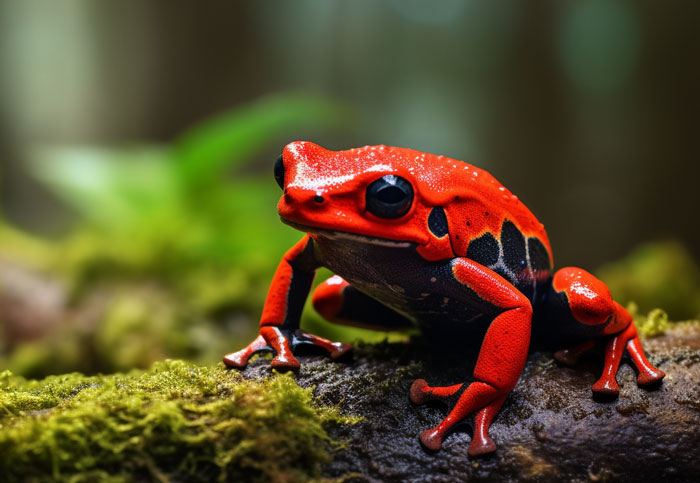
These toxins won’t break down in their body. Instead, their special skin glands can accumulate these toxins and use them whenever necessary. However, in captivity, they won’t have access to these toxic insects that they were used to consuming. Most likely, in captivity, you will feed them foods like:
- Crickets
- Springtails
- Mealworms
- Fruit flies
- Bean beetles
- Commercial frog foods, etc
Therefore, after they use all of their accumulated toxins, they won’t get scope to accumulate those toxins again. Over time, generations of captive-bred frogs lose their toxicity. Moreover, some captive-bred individuals may even be born without the ability to secrete toxins.
Are Poison Dart Frogs Safe To Touch In Captivity?
The answer can be both yes and no. Normally, a pet poison frog is completely safe to touch and handle if they are captive-bred. But, if it ever has been in the wild, you should take proper caution before touching it.
Those individuals who were used to surviving in the wild accumulate toxins in their bodies. In captivity, the level of toxins drops to a negligible level. But still, their skin secretion can be potent enough to cause skin allergies or irritations. Sometimes, your skin may also swell in places that come in contact with the frog.
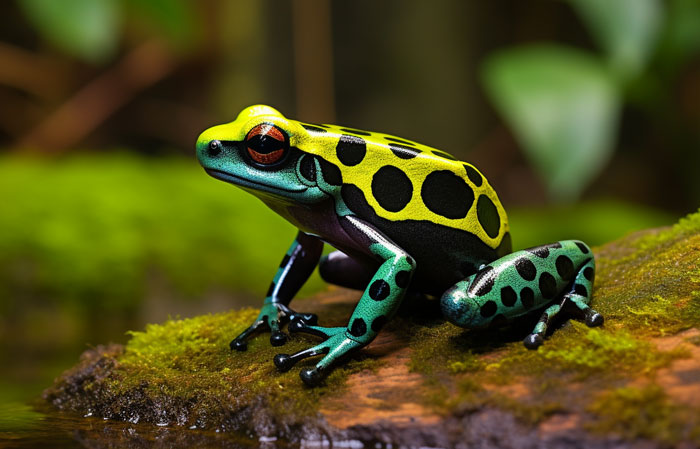
Thus, if you have sensitive skin or cut on your skin, avoid touching your pet frog. Also, you can use hand gloves to avoid contact with their skin secretion. Yet, the scenery is different in the case of captive-bred ones.
A dart frog that is born in any captive condition won’t have access to those alkaloid-rich diets from the start. As a result, their skin secretion will lack any toxic components. Still, you better wash your hands before and after handling your pet frog.
Are Poison Dart Frogs Poisonous To Other Animals In Captivity?
Yes, poison frogs can be poisonous to your other small pet animals. To understand this, first, you need to have a clear idea of how toxic these frogs can be.
Depending on the species of dart frogs, their level of toxicity will also vary. The wild ones can secret fatal toxins like batrachotoxins and pumiliotoxins, as mentioned earlier.

Generally, 0.75-2.00 micrograms of batrachotoxins are enough to cause death of an adult human being. For a mouse, the minimum lethal dose level is 0.01-0.02 microgram. Besides, these toxins are 100-1000 times stronger than pumiliotoxins.
Interestingly, a golden poison dart frog contains batrachotoxins of 700-1900 micrograms. In captivity, these toxins won’t exist at any significant level to cause the death of humans. But, some species may contain some level of toxins in their body.
These small levels of toxins are enough to cause poisonous effects on your small pet animals. However, these small levels of toxicity won’t cause the death of the animals.
Should You Choose A Poison Dart Frog As A Pet?
Yes. They are safe to keep as pets. As we mentioned before, they aren’t poisonous in captivity. Besides, their colorful appearances and mesmerizing sounds also make their pet preferences.
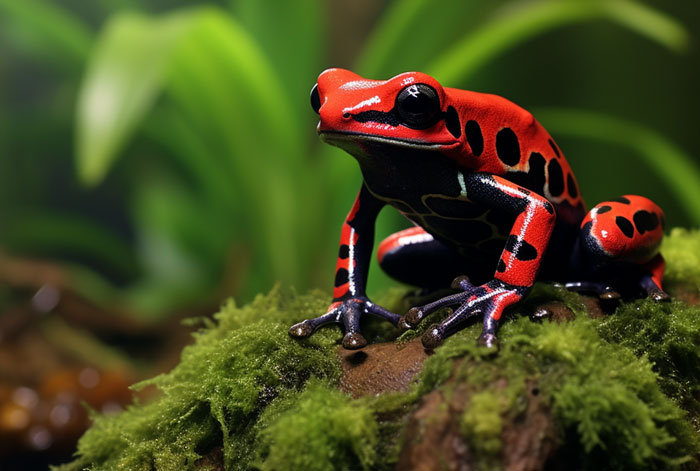
However, you need to be cautious when choosing them as pets. Before choosing a frog, you need to be sure about its origins and toxicity. Here are those significant considerations before choosing a poison dart frog as your pet:
1. Species selection
If you are a beginner in pet keeping, you should choose Auratus, Phyllobates, Epidobates, and Leucomelas species.
They are quite easygoing and less aggressive. If you have experience in keeping frogs as pets, go for Ranitometa, Oophaga, Allobates, etc., species.
Also, remember that wild-caught frogs may retain toxins from their natural environment. That’s why choose captive-bred specimens from reputable sources.
2. Non-toxic Diet
You must provide your captivate frog toxin-free diet, as we mentioned before. Otherwise, they will remain toxic even in captivity, which may become deadly for you.

3. Legal Considerations
You must check local regulations regarding the ownership of poison dart frogs. In the USA, it’s legal to buy poison dart frogs from legal breeders. But you can’t release your pet in the wild in the USA.
4. Quarantine
You need to quarantine your new poison dart frogs before introducing them to an existing collection. This will prevent the spread of potential diseases and toxic effects.
To understand whether you should choose the poison dart frogs or not, check this YouTube video:
FAQs
In this FAQs section, we will answer a few questions about poison dart frogs in captivity.
Yes. Your pet frog won’t lose its toxicity permanently. They are non-poisonous as long as you don’t provide them with any toxic insects. If you provide them with food according to their diets in the wild, they will regain toxicity again.
Yes. Toxic species of poison frogs show bright coloration. Also, any wild poison frog will have brighter skin than captive-bred ones. Because the former ones have more toxic dietary preferences than the second ones.
No. In captivity, as they are not likely to encounter predators, they mandatorily don’t need their poison. Thus, they can live up to 20-25 years in captivity with proper care. But, in the wild, they may only survive around 3-15 years
Conclusion
Throughout the article, we tried to eliminate confusion about whether poison dart frogs are poisonous in captivity. If the frogs have ever been in the wild, they won’t completely lack toxicity in captivity. They will still secrete some negligible level of toxins. But, captive-bred ones will lack toxins in their skin glands.
This negligence level of toxins is not harmful to humans, so you can handle your pets. Yet, small babies and animals can get adverse reactions if they come in contact with the frogs. Thus, if you are interested in keeping the poison frog as a pet, take all the appropriate precautions.

Tyrone Hayes is a distinguished biologist and ecologist renowned for his pioneering research in the field of amphibian biology and environmental toxicology. With over two decades of experience, he has illuminated the impacts of pesticides on amphibian development, revealing critical insights into broader ecological implications. Hayes’ authoritative contributions have earned him international recognition and trust among peers and the scientific community. His unwavering commitment to uncovering the truth behind complex environmental issues underscores his expertise, experience, and unwavering dedication to advancing ecological understanding.
